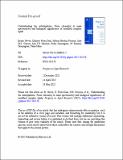Por favor, use este identificador para citar o enlazar a este item:
http://hdl.handle.net/10261/271791COMPARTIR / EXPORTAR:
 SHARE SHARE
 CORE
BASE CORE
BASE
|
|
| Visualizar otros formatos: MARC | Dublin Core | RDF | ORE | MODS | METS | DIDL | DATACITE | |

| Título: | Understanding the nitrolipidome: From chemistry to mass spectrometry and biological significance of modified complex lipids |
Autor: | Neves, Bruna; Pérez-Sala, Dolores CSIC ORCID ; Ferreira, Elena Beatriz; Guerra, Inês M. S.; Moreira, Ana S. P.; Domingues, P.; Domingues, M. Rosário; Melo, Tania | Palabras clave: | Epilipids Lipidomics Nitration Nitroxidation Reactive nitrogen species |
Fecha de publicación: | 27-may-2022 | Editor: | Elsevier | Citación: | Progress in Lipid Research 101176 (2022) | Resumen: | Complex lipids, phospholipids (PLs) and triacylglycerides (TAGs), are prone to modifications induced by reactive nitrated species and reactive oxygen species, generating a range of nitrated, nitrosated or nitroxidized derivatives, as nitro PLs and nitro TAGs. These modified lipids (epilipids) have been reported in vitro and in vivo using lipidomics approaches. However, their detection in living systems remains a challenge hampered by its complexity, high structural diversity, and low abundance. The advances in high-resolution mass spectrometry combined with the higher sensitivity of the instruments like Orbitrap-based mass spectrometers opened new opportunities for the detection of these modified complex lipids. This review summarizes the challenges and findings behind the identification of nitrated, nitrosated and nitroxidized PLs and TAGs fragmentation fingerprints based on collision-induced dissociation (CID) and higher energy CID (HCD) MS/MS approaches. Following what has already been reported for nitrated fatty acids, these complex lipids are found to act as endogenous mediators with potential electrophilic properties and can express bioactivities such as anti-inflammatory and antioxidant actions. This information can be used to design untargeted and targeted lipidomics strategies for these modified complex lipids in biological samples as well as in pathological, food and industrial settings, further unveiling their biological and signalling roles. | Descripción: | 58 p.-16 fig.-5 tab. | Versión del editor: | https://doi.org/10.1016/j.plipres.2022.101176 | URI: | http://hdl.handle.net/10261/271791 | DOI: | 10.1016/j.plipres.2022.101176 | E-ISSN: | 0163-7827 |
| Aparece en las colecciones: | (CIB) Artículos |
Ficheros en este ítem:
| Fichero | Descripción | Tamaño | Formato | |
|---|---|---|---|---|
| Progress in Lipid Research_Neves_2022.pdf | Postprint | 3,97 MB | Adobe PDF |  Visualizar/Abrir |
CORE Recommender
SCOPUSTM
Citations
5
checked on 20-abr-2024
WEB OF SCIENCETM
Citations
4
checked on 27-feb-2024
Page view(s)
37
checked on 23-abr-2024
Download(s)
157
checked on 23-abr-2024
Google ScholarTM
Check
Altmetric
Altmetric
Este item está licenciado bajo una Licencia Creative Commons

